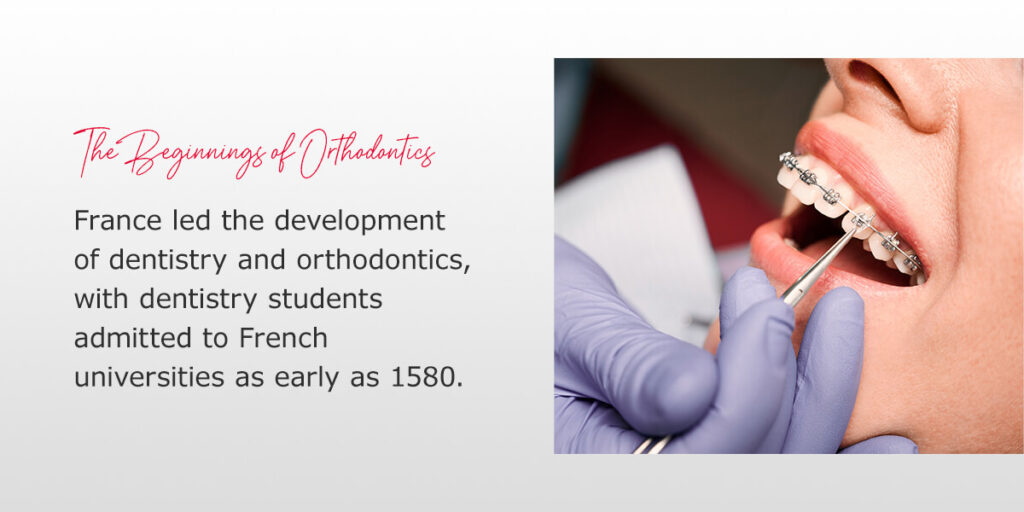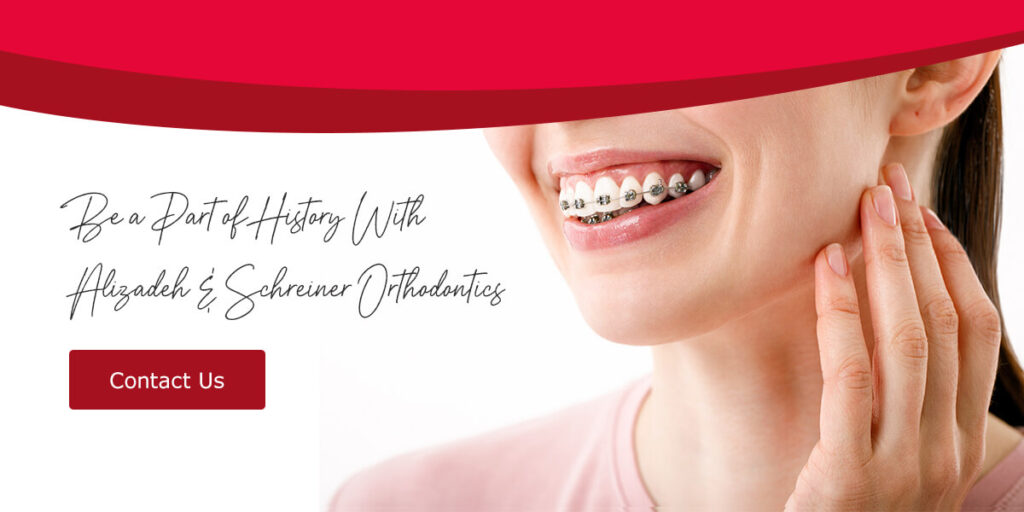Braces are a rite of passage many go through as teenagers and adults. And it turns out humans have been using braces for much longer than you would think. For thousands of years, braces have been used in different forms to help people straighten their teeth and improve their smiles. The history of braces is long and varied.
Over the past centuries, there have been significant advancements in orthodontics that have helped us understand teeth better. Braces have transformed from simple bands and wires around your teeth to the form we know today. Read on to learn more about the evolution of braces.
When were braces invented?
There is no definite answer to when braces were invented, but worrying about your smile is not new to humans. Our ancestors were concerned about how their teeth looked, how they were aligned and how to fix any irregularities. The famous philosophers Hippocrates and Aristotle wrote about dentistry in Ancient Greece, and the first dentist whose name we know was Hesy-Ra, an ancient Egyptian. There is evidence from as far back as 1,000 B.C. of people aligning teeth with braces.
The earliest examples of braces used catgut for wires, which comes from the lining of animal intestines. Thankfully, we have moved beyond that. Over time, different metals were used to fashion crude braces that helped align teeth. The ancient Etruscans, a civilization older than the Romans, used gold fixtures to keep teeth in place and maintain space in the mouth.
Fine wires made of gold, other metals and catgut have been found threaded through teeth in several Roman and Egyptian burial sites. These are some of the first known braces in human history and were used to align the teeth of the living and preserve them for the very important afterlife.

The beginnings of orthodontics
During the early middle ages, there wasn’t much progress made in the science of dentistry and orthodontics. Many people still relied on superstition and focused mainly on removing teeth to treat dental issues. There were no known specialized healers who concentrated only on teeth as we have today. Only in the 18th century was any real progress made in orthodontics and dentistry.
France led the development of dentistry and orthodontics, with dentistry students admitted to French universities as early as 1580. Pierre Dionis, a late 17th-century dentist, was the first to mention practicing dentistry as a profession and not as part of being a doctor or healer. He referred to dentists as “operators for the teeth.”
Pierre Fauchard was another French dentist who published a two-volume work titled “The Surgeon Dentist: A Treatise on the Teeth,” which described a bandeau, a horseshoe-shaped arch made of metal that teeth attached to. A generation later, Etienne Bourdet, a dentist to King Louis XV, refined this device. Bourdet was also the first recorded dentist to recommend removing teeth to reduce crowding.
We can thank a French dentist, Joachim Lefoulon, for giving orthodontics its name. In 1841 he called it “orthodontosie,” which translates into orthodontia and later orthodontics.
Who invented braces?
French dentist Christophe-Francois Delabarre invented the first modern braces we would recognize today in 1815. His dental “crib” was made of woven metal wire that fitted over the upper and lower teeth and could be worn for a long time to straighten teeth. He used the bandeau developed by predecessors and improved its design.
Gum elastics were introduced just under 30 years later by Dr. Edward Maynard. Using elastics made moving your mouth easier when full of metal. It also improved the alignment of the jaw, similar to modern braces. A few years later, E.J. Tucker started using rubber bands cut to fit comfortably in the mouth.
A significant breakthrough for braces was the invention of the dental dam. Dr. S.C. Barnum created the modern dental dam in 1864. This thin latex fits around the teeth and protects the gums when orthodontists work on teeth, especially putting on braces. Without the humble dental dam, braces could not be fixed to teeth without causing damage to gums.
These “modern braces” were still expensive and uncomfortable, as dentists would wrap teeth with bands of different metals before wiring them to teeth. The wires had to be tightened and adjusted frequently, and it was an unpleasant experience.
The evolution of braces
Over time, braces underwent many changes to become what they are today. Two major breakthroughs helped shape braces into the form we know now.
The first breakthrough was the advent of metal and metal technology. Previously, dentists would have to rely on easily malleable metals, like gold, for braces. Gold is not only expensive, but it is also very soft. This meant braces and wires would need to be adjusted often. Braces would have to be worn for a long time to reach the desired result.
The introduction of stainless steel meant braces didn’t need to be adjusted as often and more force could be applied to teeth. Braces became more affordable and could be worn for shorter periods while achieving the same results.
A more significant breakthrough happened in the 1960s and ’70s. The idea of using brackets to reposition teeth had been described for many years, but there was no way of realistically achieving this. This was before dental adhesives were developed.
Dental adhesives allowed orthodontists to stick brackets onto teeth with less damage and pain than ever before. Self-ligating brackets started to grow in popularity from there on out. These are the brackets we know today. They don’t require wires or elastics to hold the arch wire onto the bracket. Instead, the archwires are held in place by sliding mechanisms built into the brackets.
The advent of Invisalign®
Clear aligners have revolutionized the world of braces. Invented by Stanford MBA student Zia Christi in 1997, Invisalign® was the first to popularize aligner therapy – clear plastic trays that can adjust teeth the same way braces can. Christi had the idea of clear retainers when undergoing his orthodontic treatment. He found traditional retainers and braces uncomfortable and inconvenient to his lifestyle.
Clear aligners trays are made of multiple layers of polyurethane plastic and worn over your teeth like a retainer. Custom clear aligner trays are created using 3D imaging software to map out your mouth, helping you transform your smile. A significant perk of clear aligners, such as Invisalign®, is that you can remove them when you need to, like when you’re eating or need to brush your teeth.

Be a part of history with Alizadeh & Schreiner Orthodontics
Orthodontics has a long and varied history. Thankfully, we have moved on from animal gut and pulling teeth. Today, braces and orthodontic treatments are backed by years of development and innovation. Whether you choose traditional metal braces or clear aligners, our dedicated team at Alizadeh & Schreiner Orthodontics are ready to help you become a part of brace history.
Our team understands how important a smile is, and we’re here to help you. Alizadeh & Schreiner Orthodontics provides a range of services from braces to clear aligners and more to help all our patients get the smile they want. Contact us today to learn how we can help you!
